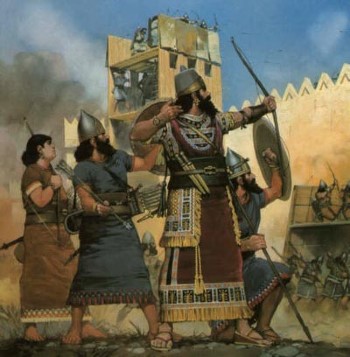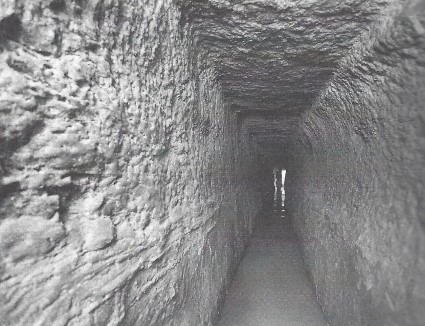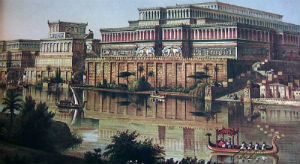A Tale of Three Cities:
Who Really Runs This World?
Jerusalem, Samaria and Nineveh were three strong cities of the ancient world. Today, Nineveh and Samaria are museum pieces while Jerusalem perseveres as a testament to hope amid confict. About 2700 years ago the prophet Isaiah was called to bring a godly perspective to the power politics of his time. Like today, most potentates and governors were seemingly oblivious to the Great God’s workings. Yet this same Sovereign God rules in the affairs of men.
By Neil Earle
Jerusalem, Samaria, and Nineveh – three cities of the ancient world well known to readers of the Bible. These three capitals were involved in a dynamic conjunction of international power politics and given a chance to conform to the will of their Creator.
Jerusalem was David’s City, the capital of ancient Judah. Samaria was the capital of Israel, to the north. Nineveh was the chief center of aggressive Assyria, in what is today Northern Iraq. It was sometime around 745 B.C., as the Assyrian Empire began to dominate the smaller nations of the Middle East, that Isaiah was called to the prophetic office (Isaiah 6:1-3).
The Assyrian Thunderbolt
Isaiah’s appointment came in the nick of time. The rulers of Nineveh were in a renewed period of expansion. Assyria reached the height of its power only after 700 B.C. “By that time the Assyrians held most of Mesopotamia, Syria, the Palestine coast, and Egypt. They enforced their rule by a deliberate policy of frightfulness, enslaving and torturing and killing thousands of captives.”
 The rulers of Nineveh were on the warpath.
The rulers of Nineveh were on the warpath.Isaiah’s call to prophesy was the thrilling overture to this tale of three cities. While the smaller Middle Eastern rulers wheeled and dealed to seek the favour of Assyria Isiaah reminded them of the Great God, before whom they were just a drop in a bucket (Isaiah 40:15). He proclaimed repentance to all three cities – “in repentance and rest is your salvation, in quietness and trust is your strength” (Isaiah 30:15). Isaiah’s very name meant “Yawheh is salvation.”
Yahweh was the God of Judah and Israel whose ten tribes and their capital cities had split off from Jerusalem some years earlier (I Kings 12). But God still had his eye on them even as they rejected him (Isaiah 28). Isaiah had a word for fierce Assyria too in their seemingly impregnable capital of Nineveh (Isaiah 10:5). A prophet named Jonah had been sent to them some years before and the Assyrians had listened (Jonah 1:1).
So, though Isaiah was based in Jerusalem, his call to repentance would remind all who would hear that the God of Israel claimed to rule in the affairs of men. This generous being stood ever ready to forgive his wayward people who had slipped into such atrocious sins as child sacrifice. (Isaiah 1:16-20). Isaiah offered shining visions of future hope that would far transcend his own day, visions of a Messiah who would appear to lead his people to lasting peace and security (Isaiah 11:1-5). But he was no impractical mystic offering platitudes while the world about him fell apart. His offer of national restoration came stamped with the glory of God himself (Isaiah 6).
“The Assyrians are Coming”
Isaiah’s ministry thus coincided with “the most momentous event [of] almost any period of Israelite history” (Lasor, Hubbard and Bush, Old Testament History, p. 279).
By 740 Tiglath-pileser had expanded into northern Syria. Israel’s king was forced to pay tribute (2 Kings 15:19). Soon, relentless Assyrian columns would slice across the upper Jordan region, seize Galilee and Gilead (Isaiah 9:1), and carry off their people into captivity.
“The Assyrians are coming!” This alarm congealed the hearts of people in the Ancient Near East. Nations trembled (Isaiah 5:26-28). Nineveh’s warlords employed calculated terror! One Assyrian leader boasted: “I stormed the mountain peaks and took them….The heads of their warriors I cut off, and I formed them into a pillar over against their city…I flayed all the chief men who had revolted” (Finegan, pp. 202-3).
This was the organized terror that threatened Samaria and Jerusalem. But Isaiah the Prophet was as relentless as the armies of Nineveh. He knew that Assyria was no match for the God of Israel.
In a daring prediction, the Jerusalem seer forecast the end of Assyria while the empire was still at its peak: “When the Lord has finished all his work against Mount Zion and Jerusalem, he will say, ‘I will punish the king of Assyria for the willful pride of his heart and the haughty look of his eyes’” (Isaiah 10:12).
Hezekiah's Legacy in Stone
Hemmed up in Jerusalem Hezekiah needed to secure the city’s water supply at the Gihon Spring just south of the city walls. To prepare for the siege Hezekiah built a pool inside the city connected to the water supply by a long tunnel (2 Kings 20:20).“Hezekiah’s Tunnel” is still there – 1749 feet long and in places 100 feet beneath the streets of the city. It was discovered in 1880 and many of our readers have walked through it as a “must do” tourist event in Jerusalem. (See picture, below left.)
Carved into the walls of the tunnel there is an inscription that reads: “While the stonecutters were still wielding the axe, each man towards his fellow…they heard the sound of each calling to his fellow…And on the days of the breakthrough, the stonecutters struck each man towards his fellows, axe against axe, and the water flowed form the source to the pool for 1200 cubits” (Shanks, Ancient Israel, page 182).
Some 1200 stamps found on jar handles in and around Jerusalem have been found bearing the inscription “lmk” meaning “belonging to the king.” The king’s own personal seal with a scarab for decoration has also come to light reading “Belonging to Hezekiah, son of Ahaz, king of Judah.”
Hezekiah was indeed a busy man and his faith inspires us today. Faith and works.
The Spreading Shadow
But before the humbling of Nineveh, Isaiah’s God had a bone to pick with the corrupt, idolatrous Israelites in their capital of Samaria. God had singled out Israel not for favors but to be an example of his way of fairness and equity. They had chosen power politics and greedy commercialism like all the other nations and with little regard for basic decency and compassion (Amos 2:6-8). Isaiah’s predecessors had noted how such leaders as Jezebel had trampled on basic principles of social justice (I Kings 21).
Isaiah’s Ode to a Vineyard was a protest song against this oveerweening evil: “When I looked for good grapes, why did it yield only bad?” (5:4). The vineyard was a symbol for Samaria but God was also calling Judah and Jerusalem to repent as well as idolatrous Israel: “And he looked for justice, but saw bloodshed; for righteousness but heard cries of distress” (Isaiah 5:7).
The Doom of Samaria
“Now I will tell you what I am going to do to my vineyard,” God said. “I will break down its wall, and it will be trampled” (Isaiah 5:5).
That happened. Samaria refused to heed even when Jerusalem’s good King Hezekiah invited them to participate in ceremonies of national repentance. “People of Israel return to the Lord,” was the message (2 Kings 30:6). Samaria scorned it (verse 10).
Judgment fell. Assyrian King Shalmaneser V (727-722) and then Sargon II (722-705) swept into Israel on their way to trounce the Egyptians. Samaria was destroyed and leveled, her people uprooted (2 Kings 17). “Israel’s proud kingdom had fallen, no more to rise” (Old Testament Survey, p. 211).
By the dreadful arithmetic of international politics it was one city down; one more to go.
Nineveh’s Turn
Nineveh, Samaria’s nemesis way off in Mesopotamia, was described as “queen city of the earth, mighty and brutal beyond imagination, head of a warrior state built on the loot of nations. Limitless wealth from the ends of the earth poured into its coffers. [The prophet] Nahum likens it to a den of ravaging lions, feeding on the blood of nations” says Halley’s Bible Handbook.
Isaiah’s God decreed doom for Nineveh: “Woe to the Assyrian, the rod of my anger, in whose hand is the club of my wrath! …The Lord, the Lord Almighty, will send wasting disease upon his sturdy warriors; under his pomp a fire will be kindled like a blazing flame” (Isaiah 10: 5, 16).
That happened. Avenging armies from Babylon and Media finally closed the ring on proud Nineveh. In 612 B.C. the city was burnt, as Isaiah and Nahum had foretold. The Assyrians had refused to repent. They had not learned the lesson that instruments of judgement can themselves be judged, that God rules in the affairs of men and that he can play rough when necessary. Those are lessons not just for Isaiah’s time but for all time (Isaiah 46:8-10).
 Hezekiah's tunnel: Anticipating an attack by Sennacherib of Assyria, the Judahite king Hezekiah (727-697 BCE) built a 1,740-foot-long tunnel to bring the water of the Gihon Spring with the city walls of Jerusalem. This successful building project (with its fresh supply of water, Jerusalem managed to withstand the Assyrian siege) is referred to in 2 Kings 20:20 and 2 Chronicles 32:4.
Hezekiah's tunnel: Anticipating an attack by Sennacherib of Assyria, the Judahite king Hezekiah (727-697 BCE) built a 1,740-foot-long tunnel to bring the water of the Gihon Spring with the city walls of Jerusalem. This successful building project (with its fresh supply of water, Jerusalem managed to withstand the Assyrian siege) is referred to in 2 Kings 20:20 and 2 Chronicles 32:4.Jerusalem Spared!
Two cities down. One to go?
No. Not quite.
In Isaiah’s day, the Assyrians under Sennacherib had reached the very walls of Jerusalem (2 Kings 18, 19). Jerusalem stood encircled like a Judahite Alamo (Isaiah 1:7-9). But Judah’s king, the righteous Hezekiah (716-687), had learned from Samaria's fall. He respected the God of Israel (2 Chronicles 30: 13-18). He prayed a prayer of repentance for him and his people: “Now, O lord our God deliver us from his hand, so that all kingdoms on earth may know that you alone, O Lord, are God” (2 Kings 19:17-19).
There is the lesson of all the prophets – God rules in the affairs of men.
Reassured by Isaiah (Isaiah 37:21-29), Hezekiah refused to be cowed by the taunts of Sennacherib’s army. He turned to God in repentance and prayer.
The results were momentous. Both biblical history (Isaiah 19:35-36) and secular archaeology hint at a setback during Sennacherib’s last campaign. The Taylor Prism in the British Museum records Sennacherib’s boast of shutting up Hezekiah in Jerusalem “like a bird in a cage.” But…it contains no record of the fall of Jerusalem. To many scholars this is evidence that Sennacherib faced an embarrassing setback outside Jerusalem (Finegan, p. 213).
The Messianic Hope
The defeat of the Assyrians after the repentance of King Hezekiah and his people saved the city of Jerusalem. It illustrated Isaiah’s theme wonderfully. “In repentance and rest is your salvation, in quietness and trust is your strength” (Isaiah 30:15).
Yes, Isaiah’s tale of three cities is more than a quaint historical survey. Isaiah’s predictions pointed beyond his time. As the Assyrian darkness encircled Judah, the prophet offered a more far-reaching hope. Out of the conquered land of Galilee there would one day come a great light (Isaiah 9:1-2). From the royal line of King David, represented by Hezekiah, would come an even mightier Deliverer (Isaiah 11:1-10).
Christians believe these prophecies were fulfilled in the ministry of Jesus of Nazareth, the prophet from Galilee. Jesus was born of a virgin as Isaiah had intimated (Isaiah 7:13-17). Jesus revealed himself throughout his ministry as the ultimate fulfillment of the hopes of his people Israel (Matthew 23:37).
But Jesus, like Isaiah, also warned of judgement for people and nations who will turn to God in repentance and faith. “Unless you repent,” Jesus preached, “you too will all perish” (Luke 13:5). Big nations and small nations. Superpowers and individuals. Judgement then and judgement now. God does not change. This makes Isaiah’s tale of three cities a powerful message for today’s superpowers and ambitious would-be fomentors of hate and terror. God is still on his throne and the God of Isaiah, the God who sent Jesus, stands ready to bless us if we change but to unleash judgement if we forsake his ways. Which will we chose?
Further Reading:
Bush and Lasor, Old Testament Survey
Strayer, Gatze, and Harbison, The Course of Civilization: Volume One, p. 30.
Finegan, Light From the Ancient Past
Neil Earle, The Battles for Mosul – Then and Now
